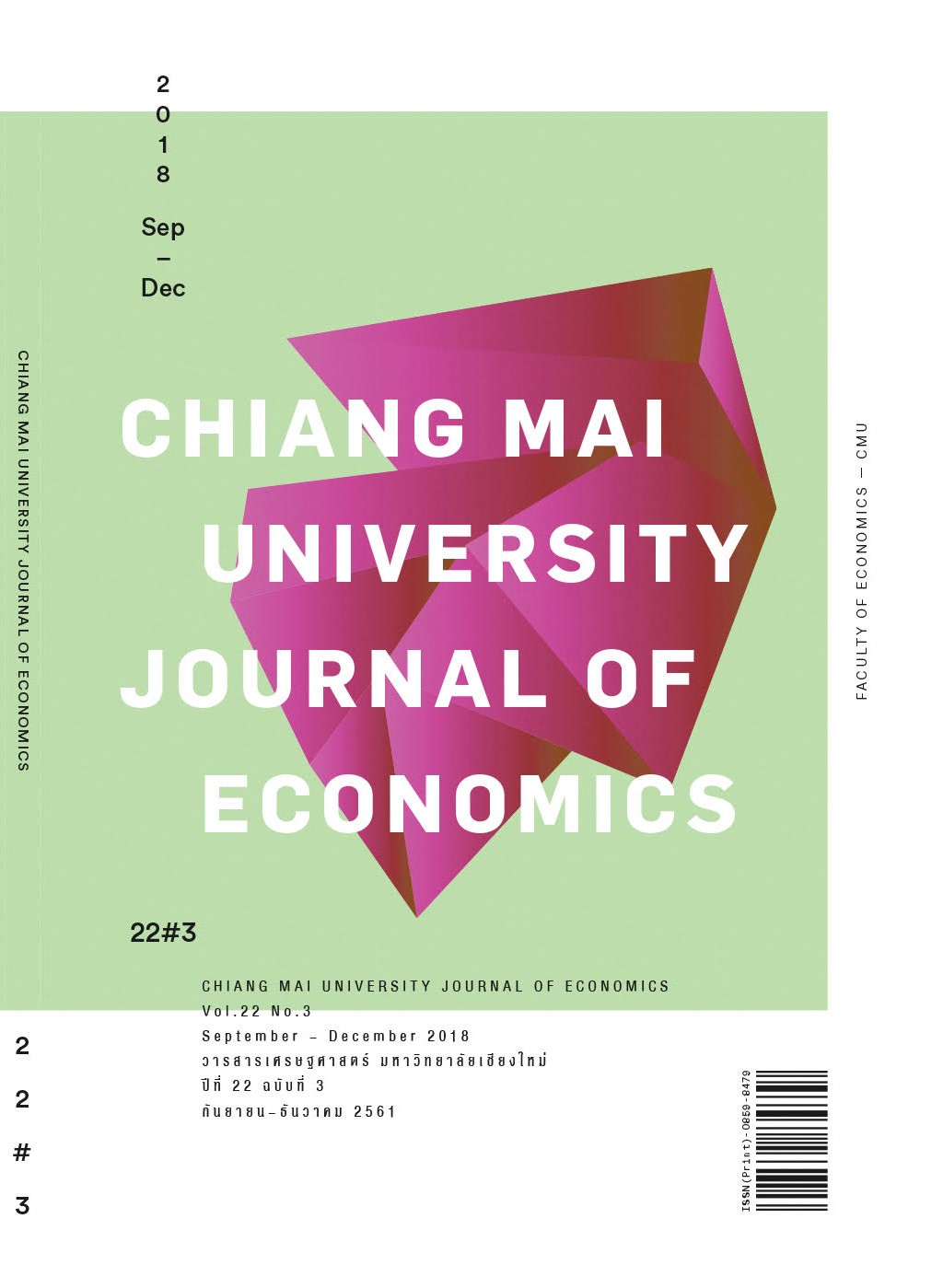Good Agricultural Practices and Coordination Strategies in Garlic Supply Chains
Keywords:
Good Agricultural Practice, Garlic Supply Chain, Vertical Coordination, Horizontal Coordination, Game TheoryAbstract
Garlic is one of the economic products cultivated in the northern region of Thailand, especially in the Chiang Mai and Mae Hong Son provinces. Currently, good agricultural practices (GAP) and supply chain coordination are the important mechanisms in which growers and other actors in the garlic supply chains share the same interest. Thus, many actors in the garlic supply chains have been attempting to find many appropriate practices or strategies to achieve their expectations in return. However, the practical intensive levels in GAP of each growers are different and the coordination strategies are accepted in some growers. Consequently, this paper aims to assess the GAP practical intensive levels and explores the best way in decision making on coordination strategy implementation by applying the game theory. The selected samples are GAP garlic growers in Chiang Mai and Mae Hong Son provinces for playing this game. The results showed that the strategy of horizontal coordination is among the GAP garlic growers as the cooperatives and the grower groups, and the vertical coordination is applied by making the contracts between the GAP garlic growers and buyers as the best choice of growers. It brings high economic payoffs and social utility. However, the effective outcomes of strategy implementation lies within the trust of GAP garlic growers and buyers, and the same standardized control in the GAP garlic products. These findings are obviously useful for the GAP garlic growers in Thailand to make a decision for changing their production behaviors from private cultivation to cooperation, as well as not selling the GAP garlic products by themselves, but exploring on the partner contracts instead.
References
Aji, J.M.M. (2016). Exploring farmer-supplier relationships in the East Java seed potato market. Agriculture and Agricultural Science Procedia, 9, 83-94.
Arshinder, K., Kanda, A. and Deshmukh, S.G. (2011). A review on supply chain coordination: Coordination mechanisms, managing uncertainty and research directions. Supply chain coordination under uncertainty, Springer, 39-82.
Department of Agriculture. (2018). GAP DOA online. [Online]. Available: https://gap.doa.go.th/plantexdata.
Ding, H., Guo, B., and Liu, Z. (2011). Information sharing and profit allotment based on supply chain coordination. International Journal of Production Economics, 133(1), 70-79.
Dries, L., Germenji, E., Noev, N., and Swinnen, J.F.M. (2009). Farmers, vertical coordination, and the restructuring of dairy supply chains in central and eastern Europe. World Development, 37(11), 1742-1758.
Gramzow, A., Batt, P.J., Afari-Sefa, V., Petrick, M., and Roothaert, R. (2018). Linking smallholder vegetable producers to markets - A comparison of a vegetable producer group and a contract-farming arrangement in the Lushoto District of Tanzania. Journal of Rural Studies, 63, 168-179.
Halil, F.M., Mohammed, M.F., Mahbub, R., and Shukur, A.S. (2016). Trust attributes to supply chain partnering in industrialised building system. Procedia - Social and Behavioral Sciences, 222, 46-55.
Henneta, J., and Arda, Y. (2008). Supply chain coordination: A game-theory approach. Engineering Applications of Artificial Intelligence, 21, 399-405.
Izquierdo, J., Fazzone, M.R., and Duran, M. (2007). Guidelines “Good Agricultural Practices for Family Agriculture.” Rome: FAO.
Liu, J., Lui, N., and Li, Y. (2011). Game analysis of enterprise, government and consumer in green supply system. International Journal of Social Science and Humanity, 1(1), 55-60.
Meqdadi, O., Johnsen, T.E., and Johnsen, R.E. (2017). The role of power and trust in spreading sustainability initiatives across supply networks: A case study in the bio-chemical industry. Industrial Marketing Management, 62, 61-76.
Nagarajan, M., and Sosic, G. (2008). Game-theoretic analysis of cooperation among supply chain agents: Review and extensions. European Journal of Operational Research, 187, 719-745.
National Bureau of Agricultural Commodity and Food Standards. (2013). Good Agricultural Practices for Food Crop. [Online]. Available: www.acfs.go.th/standard/download/ eng/GAP_Food_Crop.pdf.
Office of Agricultural Economics. (2018). Garlic: Planted area, harvested area, yield and yield per rai in 2017. [Online]. Available: https://www.oae.go.th/assets/portals/1/files/ production/%E0%B8%81%E0%B8%A3%E0%B8%B0%E0%B9%80%E0%B8%97%E0%B8%B5%E0%B8%A2%E0%B8%A1%2060.pdf.
Pezeshki, Y., Baboli, A., Cheikhrouhou, N., Modarres, M., and Jokar, M.R.A. (2013). A rewarding-punishing coordination mechanism based on trust in a divergent supply chain. European Journal of Operational Research, 30(3), 527-538.
Raj, A., Biswas, I., and Srivastava, S.K. (2018). Designing supply contracts for the sustainable supply chain using game theory. Journal of Cleaner Production, 185, 275-284.
Safari, H., and Soufi, M. (2014). A game theory approach for solving the knowledge sharing problem in supply chain. International Journal of Applied Operational Research, 4(3), 13-24.
Singh, A., and Teng, J.T.C. (2016). Enhancing supply chain outcomes through information technology and trust. Computers in Human Behavior, 54, 290-300.
Trifković, N. (2014). Certified standards and vertical coordination in aquaculture: The case of pangasius from Vietnam. Aquaculture, 433, 235-246.
Wen, Q., and Fang, H. (2012). Analysis on the dynamic game model of SMEs group loan. Advances in Applied Economics and Finance (AAEF), 2(4), 437-441.
Wilhelm, M.M. (2011). Managing coopetition through horizontal supply chain relations: Linking dyadic and network levels of analysis. Journal of Operations Management, 29, 663-676.
Wong, W.K., Qi, J., and Leung, S.Y.S. (2009). Coordinating supply chains with sales rebate contracts and vendor-managed inventory. International Journal of Production Economics, 120(1), 151-161.
Downloads
Published
Issue
Section
License
All opinions and contents in the CMJE are the responsibility of the author(s). Chiang Mai University Journal of Economics reserves the copyright for all published materials. Papers may not be reproduced in any form without the written permission from Chiang Mai University Journal of Economics.
ข้อคิดเห็นที่ปรากฏและแสดงในเนื้อหาบทความต่างๆในวารสารเศรษฐศาสตร์มหาวิทยาลัยเชียงใหม่ ถือเป็นความเห็นและความรับผิดชอบโดยตรงของผู้เขียนบทความนั้นๆ มิใช่เป็นความเห็นและความรับผิดชอบใดๆของวารสารเศรษฐศาสตร์ มหาวิทยาลัยเชียงใหม่
บทความ เนื้อหา และข้อมูล ฯลฯ ในวารสารเศรษฐศาสตร์มหาวิทยาลัยเชียงใหม่ ถือเป็นลิขสิทธิ์เฉพาะของคณะเศรษฐศาสตร์มหาวิทยาลัยเชียงใหม่ หากบุคคลหรือหน่วยงานใดต้องการนำทั้งหมดหรือส่วนหนึ่งส่วนใดไปเผยแพร่ต่อหรือเพื่อกระทำการใดๆ จะต้องได้รับอนุญาตเป็นลายลักษณ์อักษร จากวารสารเศรษฐศาสตร์ มหาวิทยาลัยเชียงใหม่






